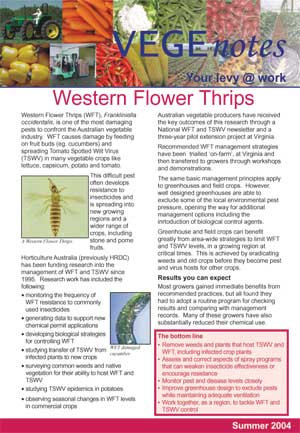|
Western Flower Thrips (WFT), Frankliniella
occidentalis, is one of the most damaging pests to confront the Australian vegetable industry. WFT causes damage by feeding
on fruit buds (eg. cucumbers) and spreading Tomato Spotted Wilt Virus
(TSWV) in many vegetable crops like lettuce, capsicum, potato and tomato.
This difficult pest often develops resistance to insecticides and is spreading into new growing regions and a wider range of crops, including stone and pome fruits.
Australian vegetable producers have received
the key outcomes of this research through a National WFT and TSWV newsletter and a three-year pilot extension project at Virginia. Recommended WFT management strategies have been trialled on-farm, at Virginia and then transfered to growers through workshops and demonstrations.


Horticulture Australia (previously HRDC) has funded research into the management of WFT and TSWV since 1995 including:
- monitoring the frequency of WFT resistance to commonly used insecticides
- generating data to support new chemical permit applications
- developing biological strategies for controlling WFT
- studying transfer of TSWV from infected plants to new crops
- surveying common weeds and native vegetation as hosts of WFT and
TSWV
- studying TSWV epidemics in potatoes
- observing seasonal changes in WFT levels in commercial crops.
The same basic management principles apply to greenhouses and field crops. However, well designed greenhouses are able to exclude some of the local environmental pest pressure, opening the way for additional management options including the inrtoduction of biological control agents.
Greenhouse and field crops can benefit
greatly from area-wide strategies to limit WFT
and TSWV levels, in a growing region at
critical times. This is achieved by eradicating
weeds and old crops before they become pest
and virus hosts for other crops.
Most growers gained immediate benefits from
recommended practices, but all found they
had to adopt a routine program for checking
results and comparing with management
records. Many of these growers have also
substantially reduced their chemical use.
|

